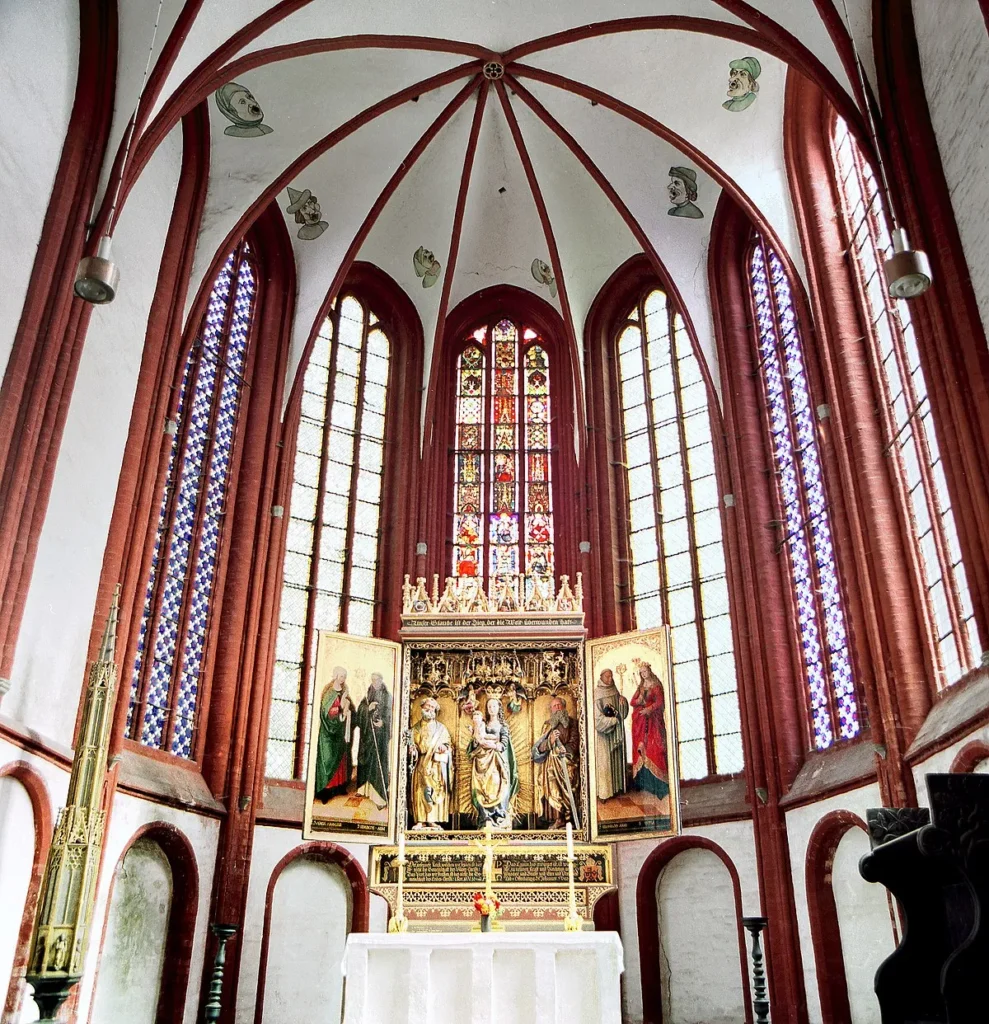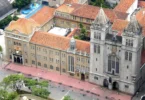
Introduction
The St. Peter and Paul cathedral (short: Brandenburg Cathedral) is the largest medieval church in Brandenburg an der Havel, Brandenburg, Germany. Construction began in 1165 as a Romanesque Saalkirche. It was expanded several times to a three-aisled Brick Gothic basilica. The cathedral is commonly designated “the cradle of the Mark Brandenburg” for its historic significance. The patron saints are Peter and Paul. St. Peter and Paul Cathedral in Brandenburg an der Havel, Germany, is a splendid example of Gothic architecture. It was originally built in the Romanesque style in the 12th century but underwent significant Gothic renovations in the 13th and 14th centuries. The cathedral is notable for its impressive twin towers and richly decorated interior, which includes medieval frescoes, a beautifully carved wooden altar, and an impressive pipe organ.
The Cathedral of St. Peter and Paul Founded in the High Middle Ages on an island between the lakes and canals of the middle Havel, and a landmark visible from far away, the Brandenburg Cathedral has always been a central place of spiritual and cultural life in the city and the country

The Brandenburg Cathedral is located on an island between the Beetzsee and the river Havel. The ensemble of cathedral, cloister, curia and side buildings still dominate the cathedral island city district of Brandenburg. Emperor Otto I founded the Diocese of Brandenburg here in 948 on top of an older Slavic fortress. The original settlement was probably lost in the Slavic revolt of 983. The Diocese of Brandenburg was restored in 1161 as part of the successful eastward expansion of the Holy Roman Empire and the previous establishment of the Margraviate of Brandenburg by Albert the Bear in 1157.
The laying of the foundation stone for the initial Romanesque construction was documented in 1165. The building was planned as a single-nave, cross-shaped Romanesque Saalkirche made of brick. The plans were expanded to a three-aisled basilica with two west towers and an elevated choir. A crypt, open towards the main nave, was added under the choir. The double tower design was reduced to a single north tower and a stump of the south tower, likely due to lack of money or unstable soil. The western front is supported by attached buttresses on the outside. The Gothic expansion was completed around the middle of the 15th century. It is the oldest pure brick building in the state of Brandenburg with a reliable construction date and is often referred to as “the cradle of the Mark Brandenburg”.
Following the Reformation, the Catholic Diocese of Brandenburg lost the cathedral and it became Protestant. Today, the church parish belongs to the Evangelical Church in Berlin, Brandenburg and Silesian Upper Lusatia.[citation needed]
The interior is characterized by white walls with accented red bands along arches, windows and ribbed vaults. The main arches along the nave are rounded in the older Romanesque style whereas the ribbed vaults and windows are in later pointed Gothic style. The church is richly decorated with works of art from the Middle Ages to the 20th century. There are several elaborate stone epitaphs for local clergymen and dukes. The wooden pulpit contains elaborate carvings with floral motifs and colored statues of Peter and Paul.
The triptych “Bohemian Altar” contains carved figures of a coronation of Mary and four saints in the center flanked by twelve saints each on a golden background. It can be dated to 1375 and is connected with the visit of Emperor Charles IV to Brandenburg, when he donated valuable relics to the cathedral. The cathedral monastery archive is the oldest archive east of the river Elbe and contains the document with the first mention of the city of Berlin in 1244.
The main church organ by local organ builder Joachim Wagner was installed in 1725. It has been preserved almost entirely in its original condition. Brandenburg’s St. Peter and Paul Cathedral is considered the mother of all Brandenburg churches. The island on which it was built is the birthplace of the Prince-Bishopric of Brandenburg, which a thousand years later became Brandenburg State.
In 928, the Germans sacked Brandenburg, the last fortress of the Slavonic tribes living east of River Elbe. A first church was erected shortly after. However, this first cathedral was burned to the ground in a Slavonic uprising in 983. The cornerstone for the current cathedral was laid on October 11, 1165. Construction of quire, crossing and transept was completed in 1173. The only part left of this original, Romanesque building are the arcaded sidewalks on both sides of the quire.
Between the 12th and the 15th century, a series of reconstructions gradually shaped the building into Gothic style. The last piece, the northern tower, was completed in 1672. The last large scale renovation took place in the 1960s. For 357 years, the cathedral was the center of the Catholic Brandenburg Cathedral Chapter. During the Reformation, the Catholic Church lost the property. Ever since, it has served as the center of Brandenburg’s Evangelic Church.
In the year 948 King Otto I founded the diocese for the Slavic mission. The attempted mission failed in the year 983. Foundation charter for the Cathedral Chapter Brandenburg Magdeburg between March and May 1161
The foundation of the Cathedral Chapter marks the reinstitution of the diocese. Four years later the cathedral is erected. Sepulchral stele, middle of the 12th century, Bernburg sandstone
The stele was discovered in the Petri Chapel and is considered to be one of the earliest items documenting Christianity in Brandenburg. Gravestone of Peter von Thure, † 1282
The oldest gravestone today stands in the northern transept. The halo indicates the significance of the deceased. St. Peter and Paul’s Cathedral was founded in 1165 as a Romanesque cathedral. Around 1295, its extension in Flamboyant Gothic style began, which allowed the cathedral to be transformed into a hall church. It was only with the completion of the vaulting of the nave and the east building that the Gothic conversion was completed from 1426 to around 1460.
Architecture of St Peter and Paul Cathedral Brandenburg, Germany

The Monastery of St. Paul was founded in the 13th century but was built in several phases, the last of which was completed in 1497 with the construction of the chapel and library. After the Reformation, the monastery came into the possession of the city, which operated a hospital and a benefactor’s house there. The church served as a Protestant parish church from 1560, and the monastery and church burned down during the Second World War. Since 2008, St. Paul’s Monastery has been open to the public again. It houses the State Archaeological Museum. The monastery church serves as a venue for events.
In the 10th century, Brandenburg, the main castle of the Slavic Hevellis, stood on the site of today’s Cathedral of St. Peter and Paul . It was conquered by King Henry I in 928/929. King Otto I probably founded the first missionary bishopric east of the Elbe here in 948, which was lost again in the great Slavic uprising in 983.
After the final conquest of Brandenburg in 1157, the foundation stone for the Romanesque cathedral was laid in 1165, and its structure has largely been preserved. The east building and choir were probably usable in 1173, the three-aisled, flat-roofed nave was completed by 1200, and a double-tower façade was begun. The crypt, which was subsequently built under the choir and crossing by 1200, was re-vaulted around 1220 over rich, imported stone columns, and the “Colorful Chapel” was added by 1235.
The High Gothic extension began around 1295, which envisaged the conversion into a hall church. The cathedral Gothic western building project, unique in the Mark, with a figuratively decorated western portal, also remained unfinished. The Gothic redesign was only completed with the raising and vaulting of the nave and eastern building from 1426 to around 1460.
The foundations of the cathedral lie partly in the filled-in moats, which led to serious structural damage. The neo-Gothic restoration took place on the outside from 1833-36, and on the inside from 1848-50. Further foundation securing took place in the 1960s. However, it was only with the help of the Brandenburg Cathedral Association that so many donations were collected that the cathedral could be secured using the latest technology and methods.
In the three-wing cloister on the north side of the cathedral, the cathedral canons lived in a monastic community according to the rules of the Premonstratensian Order. The “Spiegelburg”, the oldest preserved part, was built shortly after the foundation stone of the cathedral was laid in 1165 and probably served as a bishop’s palace. Only small remains of other cloister buildings from this period have survived.
Construction of the current cloister began around 1220/30 with the east wing and the southern bays of the cloister. A few years later, the ground floor of the north wing was also completed. The cloister took on its current appearance in several construction phases. Shortly after the middle of the 15th century, the monastery library was built on the upper floor of the northern cloister. The humanist Hartman Schedel recorded its rich murals in his notes, and impressive remains of this wall painting were recently uncovered during restoration.
When communal living was abolished in 1507, the cloister lost its original function. The Knight’s Academy, founded in 1705, used the cloister as a school and living quarters until the end of World War II. In 1869/70, the west wing was replaced by the representative neo-Gothic school building. The Theodor Neubauer High School was housed here between 1945 and 1975. The Protestant primary school, which began teaching in 2001, continues the long educational tradition at Brandenburg Cathedral.
Activities

The Brandenburg ad Havel Cathedral has a new harpsichord. It was inaugurated with a solo concert by the renowned harpsichordist Elina Albach on October 1, 2022 in the St. Petri Chapel in the presence of the creator of the instrument, Markus Fischinger. The respected piano and harpsichord maker created the instrument in the Flemish building tradition of the 17th/18th century with a two-manual layout, a lute slide and transposing devices in his Berlin workshop.
Feast Day
Feast day : 29th June
The feast day dedicated to Saints Peter and Paul is celebrated on June 29th.
Church Mass Timing
Sunday Masses: 10:00 AM
Weekday Masses: Often held in the morning, but specific times can vary.
Church Opening Time
Monday to Friday : 10.00 AM – 05.00 PM
Contact Info
Address :
Burghof 9, 14776 Brandenburg an der Havel, Germany
Phone : +49 3381 2112223
Accommodations
Connectivities
Airport
Berlin Brandenburg Airport (BER), Melli-Beese-Ring 1, 12529 Schönefeld, Germany to St peter and Paul Cathedral Brandenburg Germany Distance 59 min (85.5 km) via A10
Railway
Brandenburg Hauptbahnhof Railway Station to St peter and Paul Cathedral Brandenburg Germany Distance 6 min (2.0 km) via Geschwister-Scholl-Straße








